Abstract
Photosynthesis was examined in leaves of Flaveria brownii A. M. Powell, grown under either 14% or 100% full sunlight. In leaves of high light grown plants, the CO2 compensation point and the inhibition of photosynthesis by 21% O2 were significantly lower, while activities of ribulose 1,5-bisphosphate carboxylase/oxygenase and various C4 cycle enzymes were considerably higher than those in leaves grown in low light. Both the CO2 compensation point and the degree of O2 inhibition of apparent photosynthesis were relatively insensitive to the light intensity used during measurements with plants from either growth conditions. Partitioning of atmospheric CO2 between Rubisco of the C3 pathway and phosphoenolpyruvate carboxylase of the C4 cycle was determined by exposing leaves to 14CO2 for 3 to 16 seconds, and extrapolating the labeling curves of initial products to zero time. Results indicated that ∼94% of the CO2 was fixed by the C4 cycle in high light grown plants, versus ∼78% in low light grown plants. Thus, growth of F. brownii in high light increased the expressed level of C4 photosynthesis. Consistent with the carbon partitioning patterns, photosynthetic enzyme activities (on a chlorophyll basis) in protoplasts from leaves of high light grown plants showed a more C4-like pattern of compartmentation. Pyruvate, Pi dikinase and phosphoenolpyruvate carboxylase were more enriched in the mesophyll cells, while NADP-malic enzyme and ribulose 1,5-bisphosphate carboxylase/oxygenase were relatively more abundant in the bundle sheath cells of high light than of low light grown plants. Thus, these results indicate that F. brownii has plasticity in its utilization of different pathways of carbon assimilation, depending on the light conditions during growth.
Full text
PDF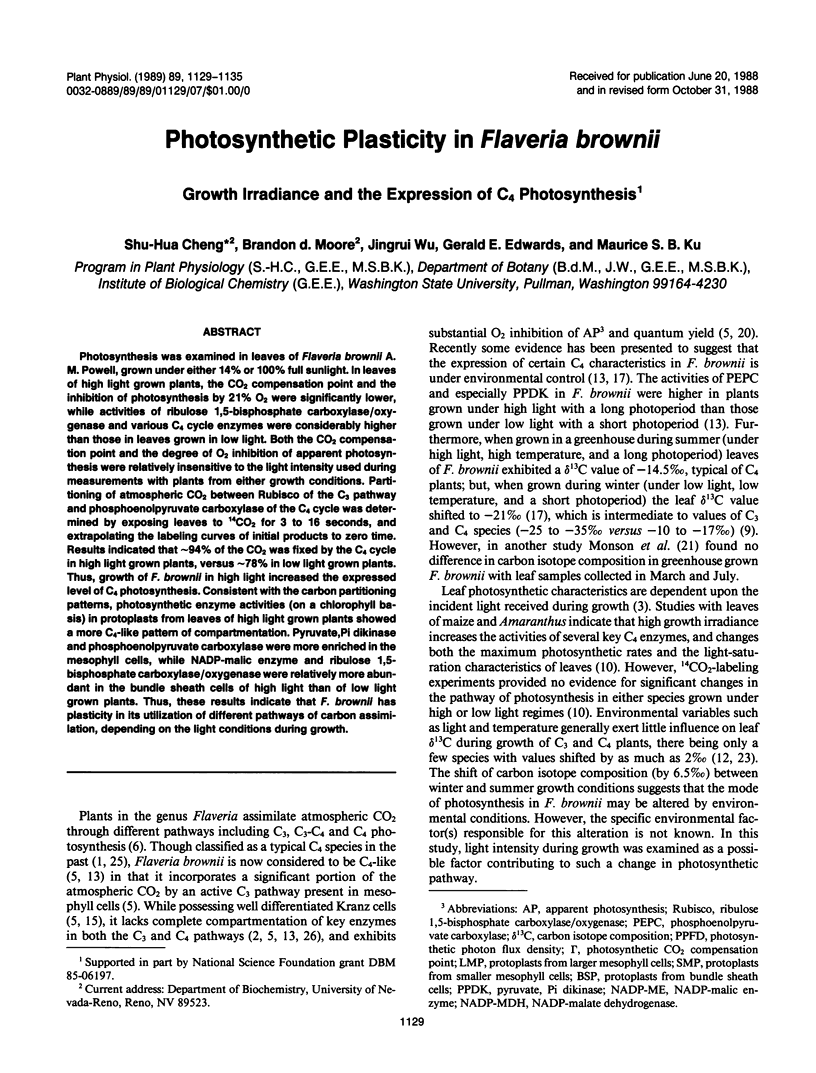
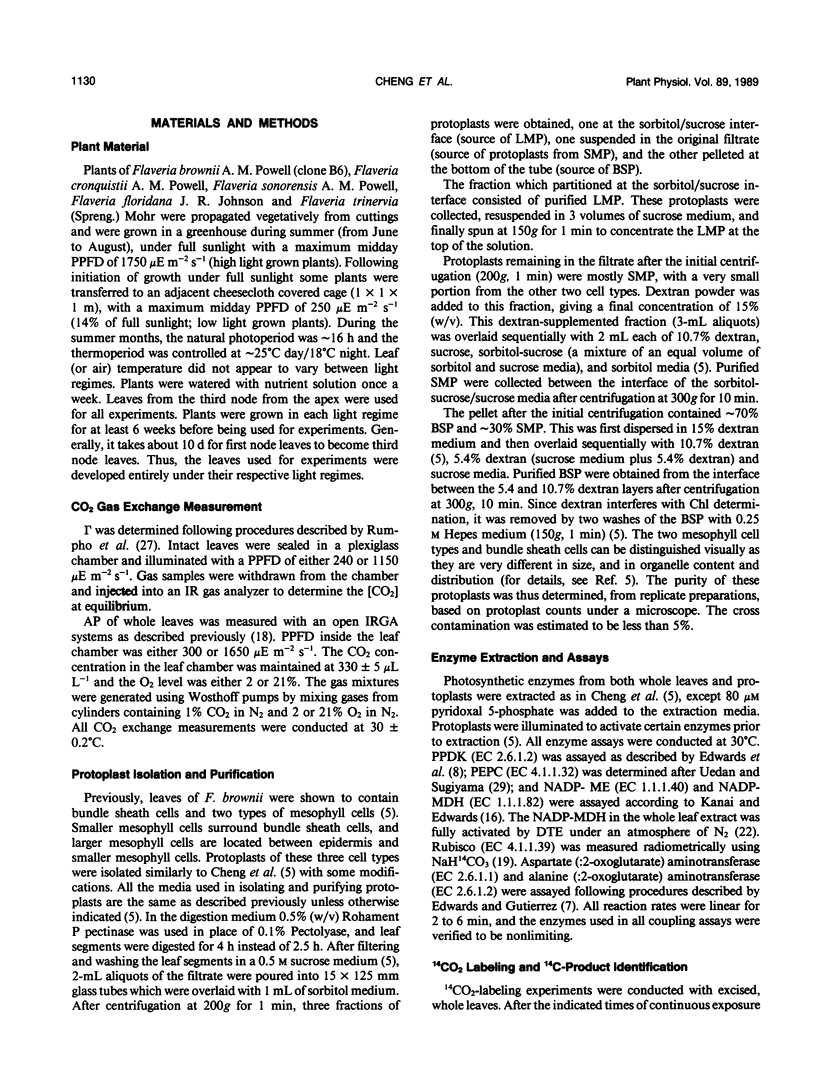
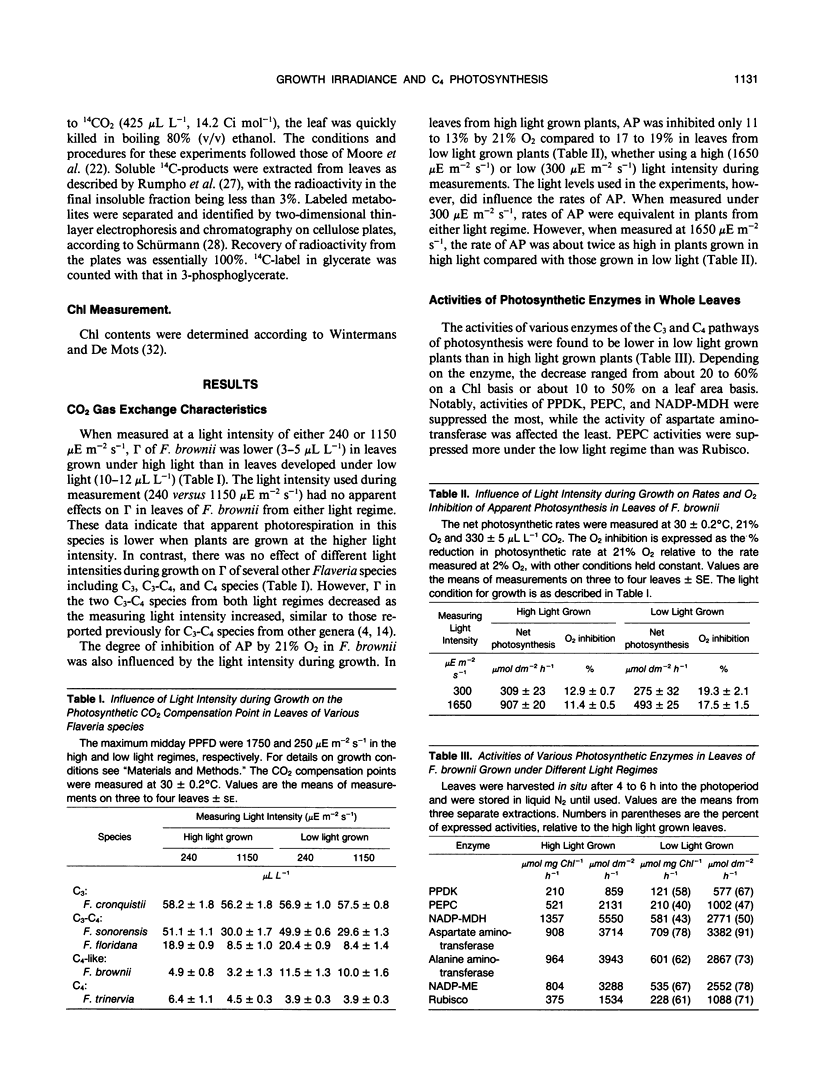
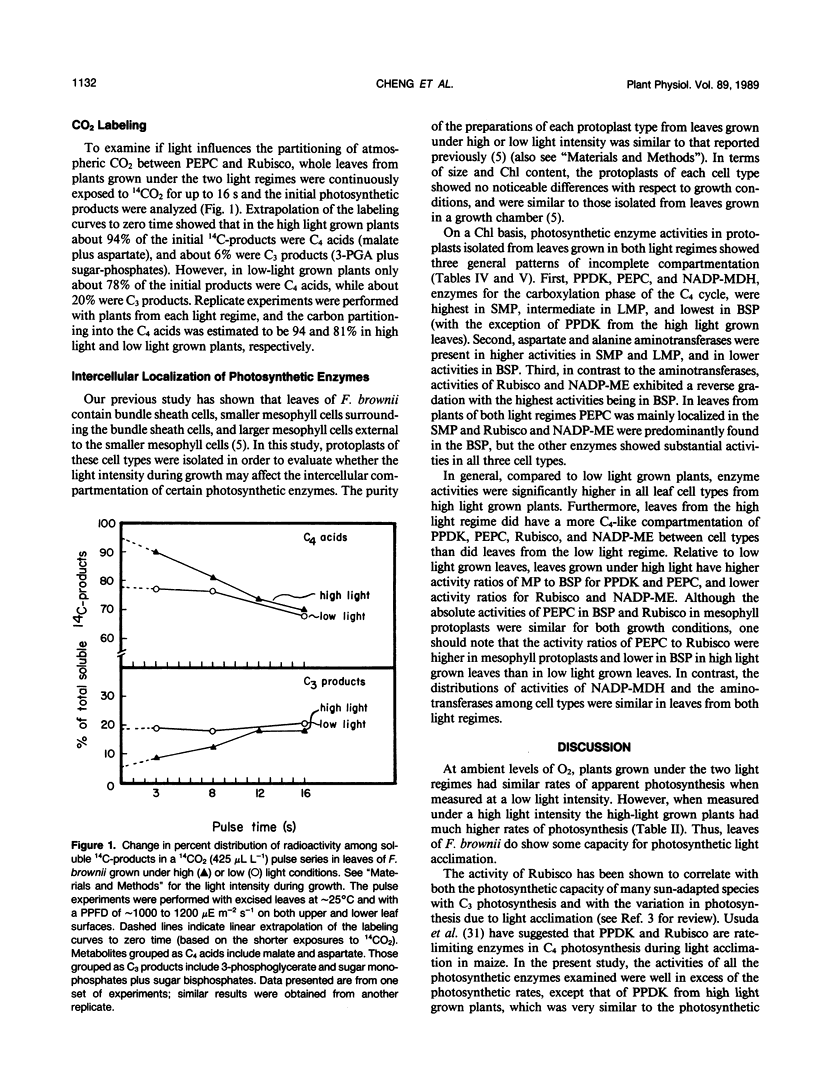
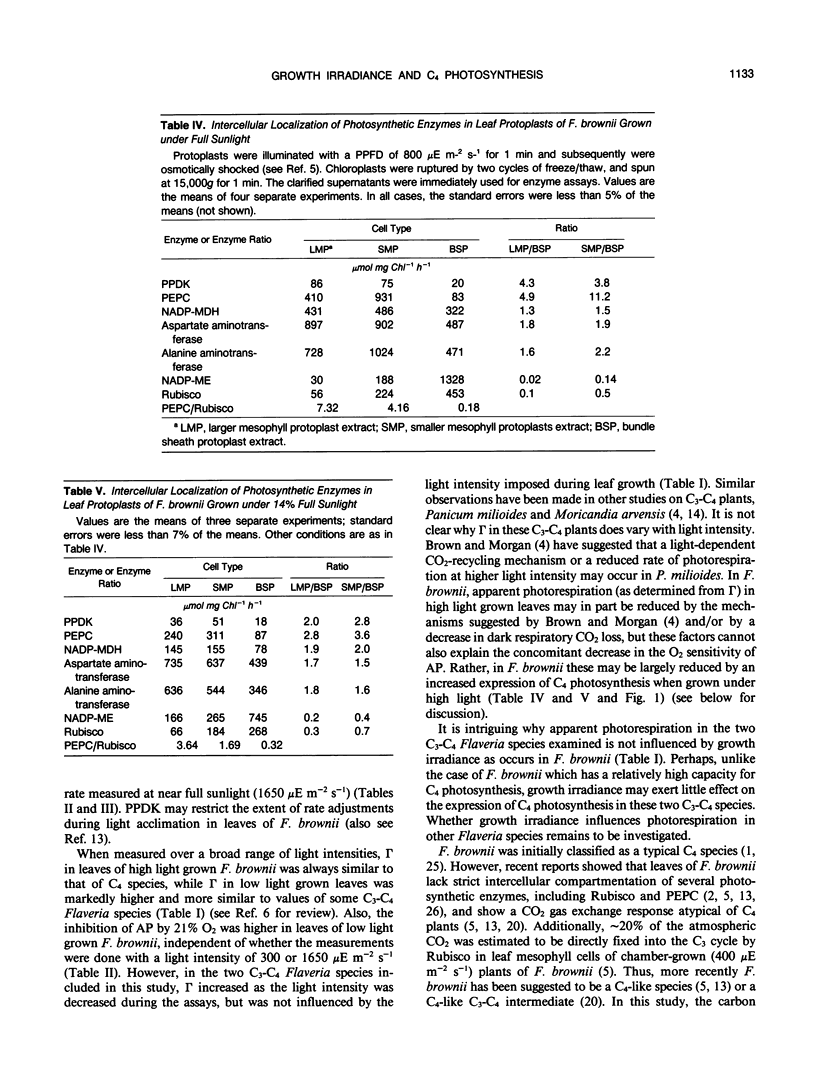
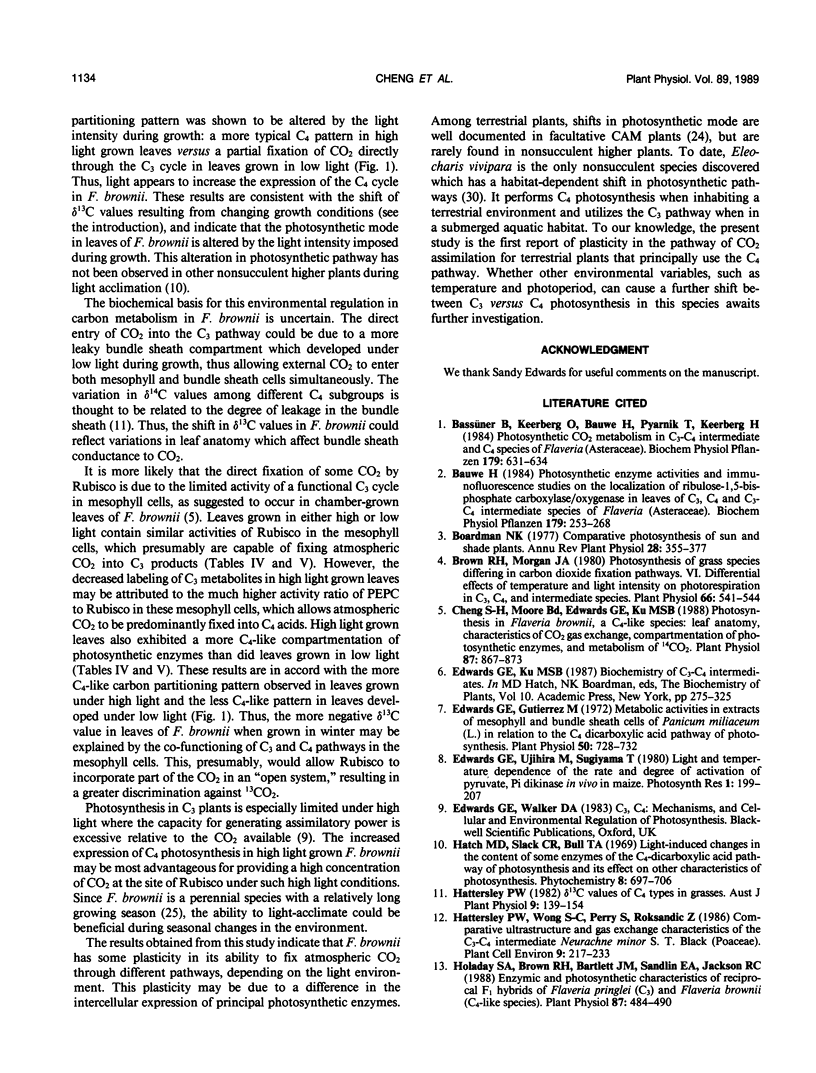
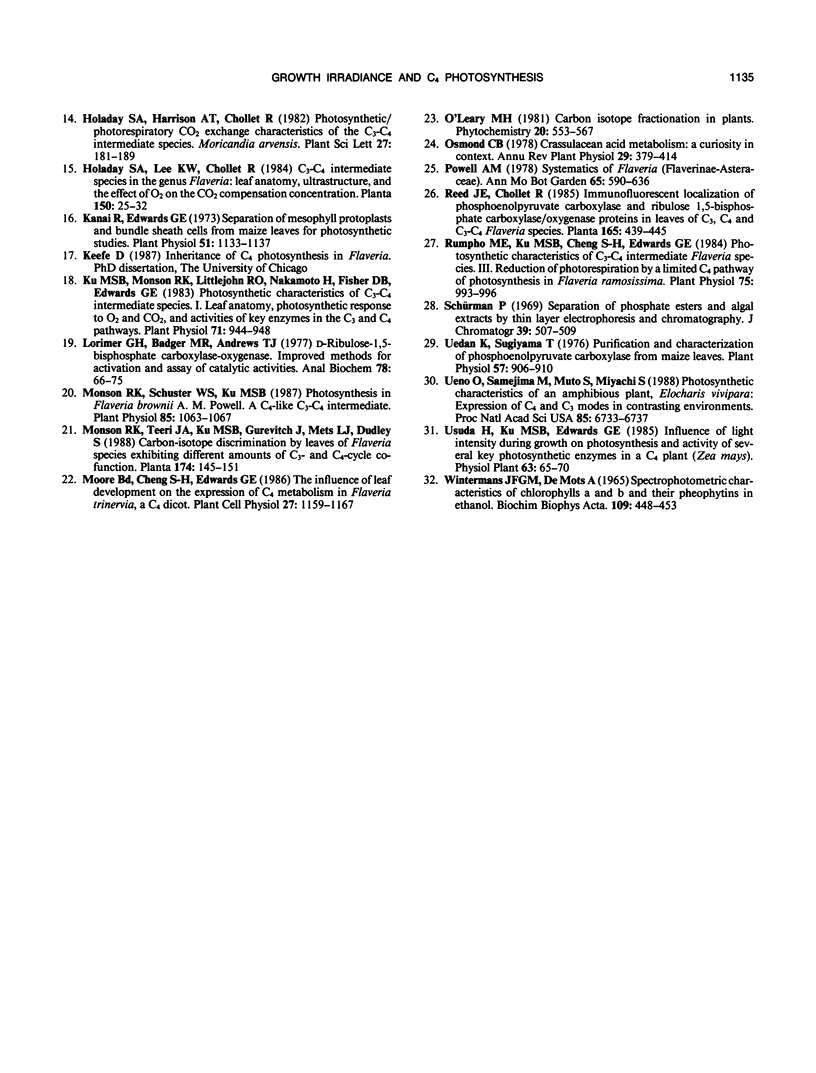
Selected References
These references are in PubMed. This may not be the complete list of references from this article.
- Brown R. H., Morgan J. A. Photosynthesis of Grass Species Differing in Carbon Dioxide Fixation Pathways : VI. DIFFERENTIAL EFFECTS OF TEMPERATURE AND LIGHT INTENSITY ON PHOTORESPIRATION IN C(3), C(4), AND INTERMEDIATE SPECIES. Plant Physiol. 1980 Oct;66(4):541–544. doi: 10.1104/pp.66.4.541. [DOI] [PMC free article] [PubMed] [Google Scholar]
- Cheng S. H., Moore B. D., Edwards G. E., Ku M. S. Photosynthesis in Flaveria brownii, a C(4)-Like Species: Leaf Anatomy, Characteristics of CO(2) Exchange, Compartmentation of Photosynthetic Enzymes, and Metabolism of CO(2). Plant Physiol. 1988 Aug;87(4):867–873. doi: 10.1104/pp.87.4.867. [DOI] [PMC free article] [PubMed] [Google Scholar]
- Edwards G. E., Gutierrez M. Metabolic Activities in Extracts of Mesophyll and Bundle Sheath Cells of Panicum miliaceum (L.) in Relation to the C(4) Dicarboxylic Acid Pathway of Photosynthesis. Plant Physiol. 1972 Dec;50(6):728–732. doi: 10.1104/pp.50.6.728. [DOI] [PMC free article] [PubMed] [Google Scholar]
- Holaday A. S., Brown R. H., Bartlett J. M., Sandlin E. A., Jackson R. C. Enzymic and Photosynthetic Characteristics of Reciprocal F(1) Hybrids of Flaveria pringlei (C(3)) and Flaveria brownii (C(4)-Like Species). Plant Physiol. 1988 Jun;87(2):484–490. doi: 10.1104/pp.87.2.484. [DOI] [PMC free article] [PubMed] [Google Scholar]
- Kanai R., Edwards G. E. Separation of mesophyll protoplasts and bundle sheath cells from maize leaves for photosynthetic studies. Plant Physiol. 1973 Jun;51(6):1133–1137. doi: 10.1104/pp.51.6.1133. [DOI] [PMC free article] [PubMed] [Google Scholar]
- Ku M. S., Monson R. K., Littlejohn R. O., Nakamoto H., Fisher D. B., Edwards G. E. Photosynthetic Characteristics of C(3)-C(4) Intermediate Flaveria Species : I. Leaf Anatomy, Photosynthetic Responses to O(2) and CO(2), and Activities of Key Enzymes in the C(3) and C(4) Pathways. Plant Physiol. 1983 Apr;71(4):944–948. doi: 10.1104/pp.71.4.944. [DOI] [PMC free article] [PubMed] [Google Scholar]
- Lorimer G. H., Badger M. R., Andrews T. J. D-Ribulose-1,5-bisphosphate carboxylase-oxygenase. Improved methods for the activation and assay of catalytic activities. Anal Biochem. 1977 Mar;78(1):66–75. doi: 10.1016/0003-2697(77)90009-4. [DOI] [PubMed] [Google Scholar]
- Monson R. K., Schuster W. S., Ku M. S. Photosynthesis in Flaveria brownii A.M. Powell : A C(4)-Like C(3)-C(4) Intermediate. Plant Physiol. 1987 Dec;85(4):1063–1067. doi: 10.1104/pp.85.4.1063. [DOI] [PMC free article] [PubMed] [Google Scholar]
- Rumpho M. E., Ku M. S., Cheng S. H., Edwards G. E. Photosynthetic Characteristics of C(3)-C(4) Intermediate Flaveria Species : III. Reduction of Photorespiration by a Limited C(4) Pathway of Photosynthesis in Flaveria ramosissima. Plant Physiol. 1984 Aug;75(4):993–996. doi: 10.1104/pp.75.4.993. [DOI] [PMC free article] [PubMed] [Google Scholar]
- Schürmann P. Separation of phosphate esters and algal extracts by thin-layer electrophoresis and chromatography. J Chromatogr. 1969 Feb 25;39(4):507–509. [PubMed] [Google Scholar]
- Uedan K., Sugiyama T. Purification and characterization of phosphoenolpyruvate carboxylase from maize leaves. Plant Physiol. 1976 Jun;57(6):906–910. doi: 10.1104/pp.57.6.906. [DOI] [PMC free article] [PubMed] [Google Scholar]
- Ueno O., Samejima M., Muto S., Miyachi S. Photosynthetic characteristics of an amphibious plant, Eleocharis vivipara: Expression of C(4) and C(3) modes in contrasting environments. Proc Natl Acad Sci U S A. 1988 Sep;85(18):6733–6737. doi: 10.1073/pnas.85.18.6733. [DOI] [PMC free article] [PubMed] [Google Scholar]
- Wintermans J. F., de Mots A. Spectrophotometric characteristics of chlorophylls a and b and their pheophytins in ethanol. Biochim Biophys Acta. 1965 Nov 29;109(2):448–453. doi: 10.1016/0926-6585(65)90170-6. [DOI] [PubMed] [Google Scholar]


